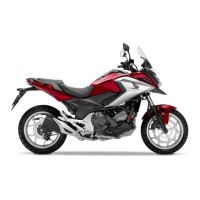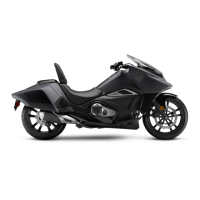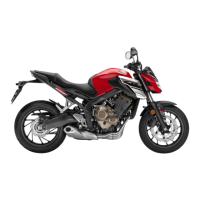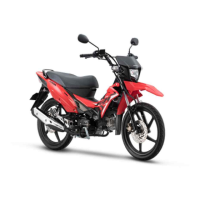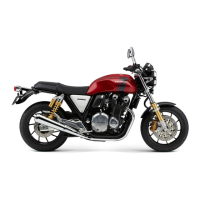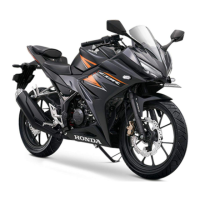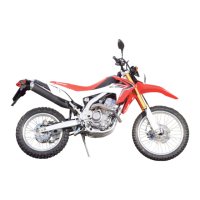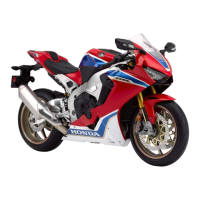Do you have a question about the Honda NC750X 2018 and is the answer not in the manual?
Essential guidelines for safe motorcycle operation and rider preparedness.
Information conveyed by safety labels on the motorcycle.
Crucial precautions for rider and passenger safety during operation.
Specific precautions to follow while riding the motorcycle safely.
Advice on using and installing accessories and modifications safely.
Guidelines for safely loading cargo onto the motorcycle.
Identification of key motorcycle parts and their locations.
Explanation of the motorcycle's instrument panel displays and functions.
Meaning and function of various warning and indicator lights on the dashboard.
Location and operation of all motorcycle control switches.
Step-by-step procedure for starting the motorcycle's engine.
Guidance on operating the motorcycle's transmission and gear shifting.
Instructions and guidelines for safely refueling the motorcycle.
Information on using the motorcycle's storage compartments like luggage boxes.
Explains why regular maintenance is crucial for motorcycle safety and performance.
Outlines recommended maintenance intervals for various motorcycle components.
Core principles and procedures for performing motorcycle maintenance tasks.
Steps to diagnose and resolve issues when the engine fails to start.
Troubleshooting procedures for engine overheating issues.
Explains the meaning of various warning lights and indicators.
Guidance on dealing with tire punctures and wheel removal.
Overview of instruments, controls, and additional features of the motorcycle.
Instructions on how to properly wash, clean, and maintain the motorcycle's appearance.
Guidelines for preparing and storing the motorcycle for extended periods.
Recommendations for safely transporting the motorcycle.
Information on environmentally responsible motorcycle ownership practices.
Location and importance of VIN and engine serial numbers.
Details about the motorcycle's systems for controlling exhaust and evaporative emissions.
Information on the function and care of the catalytic converter.
Guidance on using oxygenated fuels and potential issues.
Information on obtaining service and owner's manuals.
Details on motorcycle warranty coverage and service procedures.
Contact information for Honda customer support and service.
Key physical and dimensional specifications of the motorcycle.
Technical data related to maintenance, fluids, and parts.
Essential guidelines for safe motorcycle operation and rider preparedness.
Information conveyed by safety labels on the motorcycle.
Crucial precautions for rider and passenger safety during operation.
Specific precautions to follow while riding the motorcycle safely.
Advice on using and installing accessories and modifications safely.
Guidelines for safely loading cargo onto the motorcycle.
Identification of key motorcycle parts and their locations.
Explanation of the motorcycle's instrument panel displays and functions.
Meaning and function of various warning and indicator lights on the dashboard.
Location and operation of all motorcycle control switches.
Step-by-step procedure for starting the motorcycle's engine.
Guidance on operating the motorcycle's transmission and gear shifting.
Instructions and guidelines for safely refueling the motorcycle.
Information on using the motorcycle's storage compartments like luggage boxes.
Explains why regular maintenance is crucial for motorcycle safety and performance.
Outlines recommended maintenance intervals for various motorcycle components.
Core principles and procedures for performing motorcycle maintenance tasks.
Steps to diagnose and resolve issues when the engine fails to start.
Troubleshooting procedures for engine overheating issues.
Explains the meaning of various warning lights and indicators.
Guidance on dealing with tire punctures and wheel removal.
Overview of instruments, controls, and additional features of the motorcycle.
Instructions on how to properly wash, clean, and maintain the motorcycle's appearance.
Guidelines for preparing and storing the motorcycle for extended periods.
Recommendations for safely transporting the motorcycle.
Information on environmentally responsible motorcycle ownership practices.
Location and importance of VIN and engine serial numbers.
Details about the motorcycle's systems for controlling exhaust and evaporative emissions.
Information on the function and care of the catalytic converter.
Guidance on using oxygenated fuels and potential issues.
Information on obtaining service and owner's manuals.
Details on motorcycle warranty coverage and service procedures.
Contact information for Honda customer support and service.
Key physical and dimensional specifications of the motorcycle.
Technical data related to maintenance, fluids, and parts.
| Bore x Stroke | 77 mm x 80 mm |
|---|---|
| Compression Ratio | 10.7:1 |
| Fuel System | PGM-FI electronic fuel injection |
| Ignition | Digital transistorized with electronic advance |
| Final Drive | Chain |
| Front Tire | 120/70ZR-17 |
| Rear Tire | 160/60ZR-17 |
| Seat Height | 32.7 inches |
| Fuel Capacity | 3.7 gallons |
| Engine Type | Liquid-cooled, parallel-twin |
| Horsepower | 54 hp |
| Max Power Output | 54 hp (40.3 kW) @ 6, 250 rpm |
| Torque | 50.1 lb-ft (68 Nm) @ 4, 750 rpm |
| Transmission | 6-speed manual |
| Front Suspension | 41 mm telescopic fork; 5.4 inches travel |
| Rear Suspension | Pro-Link single shock |
| Front Brake | 320mm single disc with two-piston caliper |
| Rear Brake | 240mm single disc with single-piston caliper |
